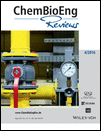Sandwich Packings: State of the Art
Steve Flechsig
University of Paderborn, Faculty of Mechanical Engineering, Chair of Fluid Process Engineering, Pohlweg 55, 33098 Paderborn, Germany.
Search for more papers by this authorÖmer Yildirim
University of Paderborn, Faculty of Mechanical Engineering, Chair of Fluid Process Engineering, Pohlweg 55, 33098 Paderborn, Germany.
Search for more papers by this authorCorresponding Author
Eugeny Y. Kenig
University of Paderborn, Faculty of Mechanical Engineering, Chair of Fluid Process Engineering, Pohlweg 55, 33098 Paderborn, Germany.
Gubkin Russian State University of Oil and Gas, Leninsky Prospect, 65/1, 119991 Moskau, Russia.
University of Paderborn, Faculty of Mechanical Engineering, Chair of Fluid Process Engineering, Pohlweg 55, 33098 Paderborn, Germany.Search for more papers by this authorSteve Flechsig
University of Paderborn, Faculty of Mechanical Engineering, Chair of Fluid Process Engineering, Pohlweg 55, 33098 Paderborn, Germany.
Search for more papers by this authorÖmer Yildirim
University of Paderborn, Faculty of Mechanical Engineering, Chair of Fluid Process Engineering, Pohlweg 55, 33098 Paderborn, Germany.
Search for more papers by this authorCorresponding Author
Eugeny Y. Kenig
University of Paderborn, Faculty of Mechanical Engineering, Chair of Fluid Process Engineering, Pohlweg 55, 33098 Paderborn, Germany.
Gubkin Russian State University of Oil and Gas, Leninsky Prospect, 65/1, 119991 Moskau, Russia.
University of Paderborn, Faculty of Mechanical Engineering, Chair of Fluid Process Engineering, Pohlweg 55, 33098 Paderborn, Germany.Search for more papers by this authorAbstract
Capacity and efficiency of packed columns can be significantly improved by the application of sandwich packings. An element of such packings consists of two alternating layers of industrially available standard packings with different specific surface areas. Sandwich packings are commonly used for operating conditions between the flooding points of both layers, with a heterogeneous flow pattern established along a sandwich packing element. There are some similarities between this flow pattern and those in conventional structured packings as well as in trays. Under certain conditions, this can be used in a beneficial way. However, the application of this integrated packing type is hindered by a lack of reliable design methods. In the present article, the results of recent activities are summarized.
References
- 1 Z. Olujic, B. Kaibel, H. Jansen, T. Rietfort, E. Zich, G. Frey, Chem. Biochem. Eng. 2003, 17 (4), 301–309.
- 2
B. Kaibel, G. Kaibel, A. Stamme, M. Stroezel, M. Kind, Chem. Ing. Tech. 2000, 9 (72), 962–963.
10.1002/1522-2640(200009)72:9<962::AID-CITE9620>3.0.CO;2-L Google Scholar
- 3 N. Kashani, M. Siegert, T. Sirch, Chem. Eng. Technol. 2005, 28 (5), 549–552.
- 4 G. Kaibel, G. Kons, H. Schoenmakers, E. Schwab, DGNK-Conference, Berlin, Oktober 2002.
- 5 B. Metzen, A. Shilkin, C. Großmann, ProcessNet Conf. on Fluid Process Engineering, Fulda, March 2010.
- 6 M. Joedecke, T. Friese, G. Schuch, B. Kaibel, H. Jansen, IChemE 2006, 152, 786–789.
- 7 www.montz.de/en/products/montz-structured-packings/standard-metal-sheet-packing-type-b1/ (Accessed on April 05, 2016)
- 8 S. Flechsig, Ö. Yildirim, E.Y. Kenig, CAPE Forum, Paderborn, April 2015.
- 9 U. Brinkmann, B. Kaibel, M. Joedecke, J. Mackowiak, E. Y. Kenig, Chem. Ing. Tech. 2011, 84 (1–2), 36–45.
- 10 Ö. Yildirim, S. Flechsig, U. Brinkmann, E. Y. Kenig, Chem. Ing. Tech. 2015, 87 (10), 1348–1356.
- 11 L. Spiegel, W. Meier, Chem. Petrol. Eng. 1994, 30 (3), 118–125.
- 12
J. Mackowiak, Fluiddynamik von Füllkörpern und Packungen, Vol. 2, Springer, Berlin 2003.
10.1007/978-3-642-55575-6 Google Scholar
- 13 G. B. Wallis, One-Dimensional Two-Phase Flow, McGraw-Hill, New York 1969.
- 14 U. Brinkmann, A. Hoffmann, B. Kaibel. M. Joedecke, E. Y. Kenig, ProcessNet Annual Meeting, Mannheim, September 2009.
- 15 R. Billet, M. Schultes, Chem. Eng. Res. Des. 1999, 77, 498–504.
- 16 Ö. Yildirim, E. Y. Kenig, Chem. Eng. Process. 2015, 98, 147–154.
- 17 W. K. Lewis, W. G. Whitman, Ind. Eng. Chem. 1924, 16, 1215–1220.
- 18 F. J. Zuiderweg, Chem. Eng. Sci. 1982, 37, 1441–1464.
- 19 Z. Olujic, A. F. Seibert, B. Kaibel, H. Jansen, T. Rietfort, E. Zich, Chem Proc. Eng. 2003, 42, 55–60.
- 20 T. Yanagi, M. Sakata, Ind. Eng. Chem. Process Des. Dev. 1982, 21, 712–717.
- 21 C. Miller, G. Kaibel, R. Benfer, Chem. Ing. Tech. 2004, 76 (6), 730–733.
- 22 N. Kashani, M. Siegert, T. Sirch, Chem. Ing. Tech. 2004, 76 (7), 929–933.
- 23
N. Kashani, M. Siegert, B. Kaibel, Chem. Ing. Tech. 2004, 76 (9), 1276.
10.1002/cite.200490126 Google Scholar
- 24 J. P. Kuchar, A. Afacan, K. T. Chuang, Chem. Eng. Res. Des. 2004, 82 (7), 813–820.
- 25 M. Jödecke, Ž. Olujić, CIT plus 2008, 10, 32–34.
- 26
M. Kopatschek, M. Grünewald, M. Schultes, Chem. Ing. Tech. 2012, 84 (8), 1246.
10.1002/cite.201250392 Google Scholar
- 27 Ö. Yildirim, S. Flechsig, E. Y. Kenig, Chem. Eng. Trans. 2015, 45, 1165–1170.
- 28 M. Jödecke, T. Friese, G. Schuch, B. Kaibel, H. Jansen, ProcessNet Conf. on Fluid Process Engineering, Würzburg, May 2006.
- 29 U. Brinkmann, A. Hoffmann, B. Kaibel, M. Jödecke, E.Y. Kenig, ProcessNet Conf. on Fluid Process Engineering, Dortmund, March 2009.
- 30 U. Brinkmann, A. Hoffmann, B. Kaibel, M. Jödecke, E.Y. Kenig, 8th World Congr. of Chemical Engineering, Symposium on Process Intensification, Montreal, August 2009.
- 31 Ö. Yildirim, U. Brinkmann, E. Y. Kenig, ProcessNet Conf. on Process, Equipment and Plant Engineering, Fulda, November 2011.
- 32 Ö. Yildirim, S. Flechsig, U. Brinkmann, E. Y. Kenig, ProcessNet Conf. on Fluid Process Engineering, Weimar, March 2012.
- 33 Ö. Yildirim, U. Brinkmann, E. Y. Kenig, ACHEMA 2012 30th World Exhibition Congr. on Chemical Engineering, Frankfurt am Main, June 2012.
- 34 Ö. Yildirim, E. Y. Kenig, ProcessNet Annual Meeting, Karlsruhe, September 2012.
- 35 M. Kopatschek, M. Grünewald, M. Schultes, ProcessNet Conf. on Fluid Process Engineering, Baden-Baden, March 2013.
- 36 S. Flechsig, Ö. Yildirim, E. Y. Kenig, ProcessNet Conf. on Fluid Process Engineering, Bremen, March 2015.




